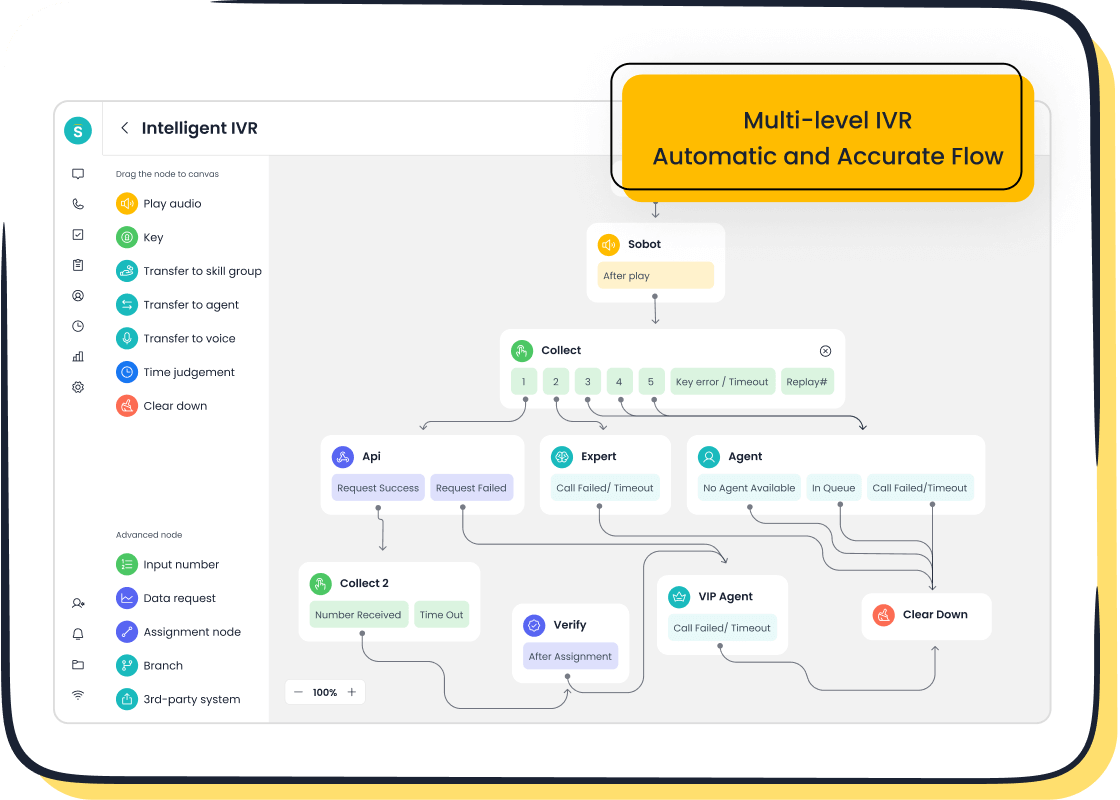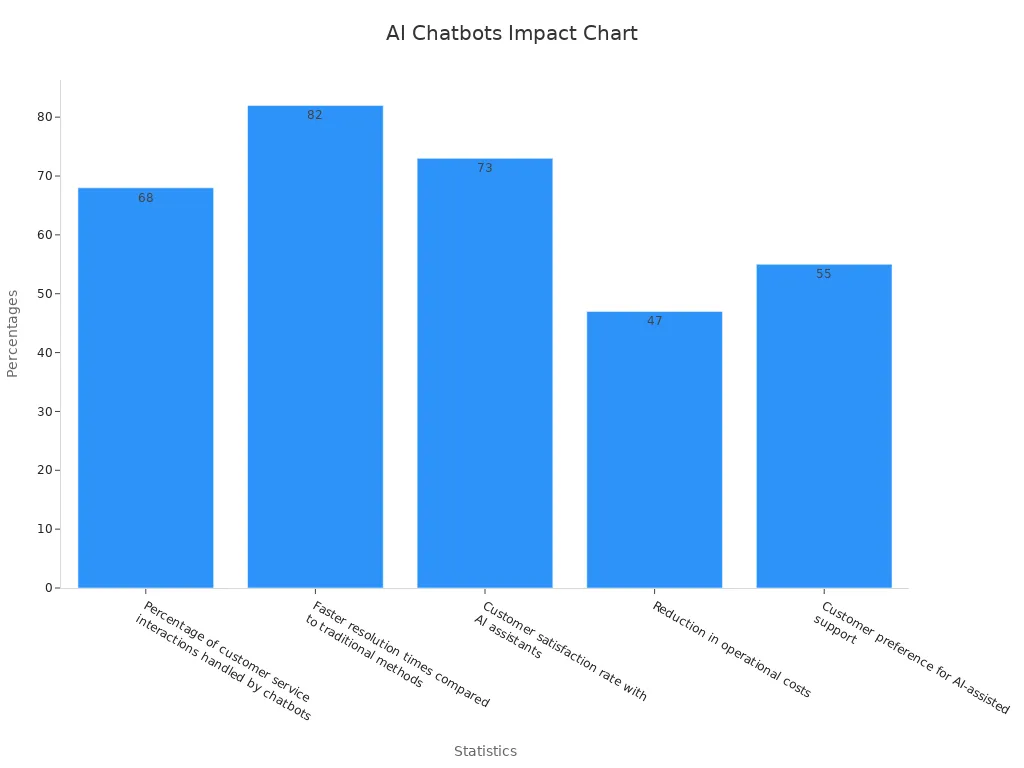Why Businesses Need Digital Customer Service Platforms Now

Meeting customer expectations has never been more critical. Today, 93% of customer service teams report a surge in customer demands, with 72% of customers expecting immediate service and 86% desiring seamless communication across channels. These rising expectations drive businesses to adopt digital customer service platforms that ensure faster, more personalized interactions. Without such tools, companies risk losing customers, as 60% of consumers choose brands based on expected service quality.
Sobot’s digital customer service platform offers a solution designed to unify communication channels, enhance the customer service experience, and improve operational efficiency. With features like AI-powered chatbots and intelligent voice solutions, Sobot enables businesses to meet these expectations while staying competitive in an evolving market.
Understanding Digital Customer Service Platforms
What Is a Digital Customer Service Platform?
A digital customer service platform is a technology solution designed to streamline and enhance how businesses interact with their customers. It integrates various communication channels, such as email, live chat, social media, and voice calls, into a single, unified system. This allows you to manage all customer interactions efficiently and deliver consistent support across multiple touchpoints.
These platforms go beyond traditional methods by incorporating advanced tools like AI-powered chatbots, automation, and real-time analytics. For example, Sobot’s digital customer service software offers features like intelligent voice solutions and omnichannel support, enabling you to provide seamless and personalized customer experiences. With the global digital transformation market projected to grow to $1,009.8 billion by 2025, adopting such platforms has become essential for businesses aiming to stay competitive.
Key Features of Digital Customer Service Platforms
Digital customer service platforms come equipped with a range of features that enhance both customer satisfaction and operational efficiency. Here are some of the key features:
| Feature | Description |
|---|---|
| Omnichannel support | Manage customer interactions across various channels like email, chat, and social media. |
| Automation capabilities | Automate tasks such as ticket routing and prioritization to save time and resources. |
| Reporting and analytics | Gain insights into metrics like response time and customer satisfaction rates. |
| Self-service options | Provide tools like knowledge bases and chatbots for customers to find answers independently. |
| Personalized interactions | Use AI and data analytics to tailor support and recommendations to individual customer needs. |
For instance, Sobot’s platform includes AI-powered voicebots and intelligent IVR systems that automate repetitive tasks, allowing your team to focus on complex issues. These features not only improve the customer experience but also reduce operational costs.
How Digital Customer Service Differs from Traditional Methods
Traditional customer service methods often rely on siloed systems and manual processes, which can lead to inefficiencies and inconsistent support. In contrast, digital customer service platforms offer a unified and automated approach. Here’s how they differ:
- Speed and Efficiency: Traditional methods require manual handling of inquiries, leading to delays. Digital platforms use automation to provide instant responses, meeting the expectations of 72% of customers who demand immediate service.
- Personalization: While traditional methods offer generic solutions, digital platforms leverage AI to deliver tailored interactions. For example, Sobot’s AI capabilities analyze customer data to provide personalized recommendations.
- Omnichannel Support: Traditional systems often struggle to manage interactions across multiple channels. Digital platforms ensure seamless communication, with 86% of consumers expecting consistent support across channels.
By adopting a digital approach, you can not only meet but exceed customer expectations, ensuring long-term loyalty and satisfaction.
Benefits of Digital Customer Service Platforms for Businesses

Enhancing Customer Experience Through Personalization
Personalization has become a cornerstone of delivering a high-quality customer experience. Customers today expect interactions tailored to their preferences and needs. Digital customer service platforms make this possible by leveraging AI and data analytics to provide personalized recommendations and solutions.
For instance, platforms like Sobot analyze customer data to understand behavior and preferences. This enables you to offer personalized customer service, such as recommending products based on past purchases or tailoring responses to individual inquiries. Research shows that personalized experiences lead to a 51% increase in conversion rates and an 87% boost in click-through rates. Additionally, 56% of consumers are more likely to become repeat customers after experiencing personalization.
By adopting digital customer service software, you can meet these expectations and foster loyalty. Personalization not only enhances the customer experience but also strengthens your brand's relationship with its audience.
Improving Operational Efficiency and Reducing Costs
Digital customer service platforms significantly improve operational efficiency while reducing costs. These platforms allow your team to handle multiple interactions simultaneously, automate repetitive tasks, and streamline workflows. This efficiency ensures that your business can meet customer needs without overburdening your resources.
Consider these statistics:
- Agents using digital platforms can manage several customer interactions at once, boosting productivity.
- 76% of shoppers expect immediate engagement, which digital tools can provide.
- Self-service options, preferred by 70% of consumers, reduce the workload on your team.
Real-world examples further highlight these benefits. For instance:
| Case Study | Operational Cost Reduction | Efficiency Gain |
|---|---|---|
| Sophos | 15% reduction in support tickets, saving 1070 man-hours | ROI of 342% |
| Horizon Credit Union | 50% reduction in average resolution time | 35% increase in member satisfaction, 20% increase in cross-selling success |
| AI Adoption | 50% reduction in response times | 35% boost in customer satisfaction, 20% increase in customer retention |
| Onboarding Overhaul | 80% reduction in onboarding duration | 90% drop in error rate in data processing |
Sobot’s solutions, such as its AI-powered voicebots and intelligent IVR systems, further enhance efficiency. These tools automate routine tasks, allowing your team to focus on complex issues, ultimately reducing costs and improving customer satisfaction.
Leveraging Real-Time Analytics for Better Decision-Making
Real-time analytics is a game-changer for businesses aiming to stay ahead in a competitive market. Digital customer service platforms collect and analyze customer data continuously, providing instant insights that help you make informed decisions.
With real-time analytics, you can monitor customer interactions as they happen. This allows you to identify trends, address issues immediately, and optimize your strategies. For example, if a product receives frequent complaints, you can act quickly to resolve the issue, improving the overall customer experience. Real-time insights also enable you to adjust marketing campaigns or sales strategies based on current customer behavior.
Sobot’s digital customer service solutions include advanced analytics tools that provide actionable insights. These tools help you understand customer needs, improve service quality, and drive better business outcomes. By leveraging real-time data, you can ensure your decisions align with customer expectations and market demands.
Why Digital Customer Service Platforms Are Essential in 2025
Meeting Omnichannel Customer Expectations
In 2025, customers will expect seamless interactions across multiple channels. Whether they reach out via email, live chat, social media, or phone, they want a consistent and personalized experience. Omnichannel strategies integrate these touchpoints, allowing you to provide smooth transitions between platforms. For example, a customer might start a conversation on social media and continue it via live chat without repeating their issue.
Omnichannel strategies enhance customer experience by integrating interactions across channels. Personalization and consistency build trust and loyalty, while channel integration ensures seamless switching between online and offline platforms.
Sobot’s digital customer service solutions excel in omnichannel support. By unifying communication channels, Sobot enables you to manage all interactions in one place. This approach not only improves efficiency but also ensures that your customers feel valued and understood.
The Role of AI and Automation in Digital Customer Service
AI and automation are transforming how businesses handle customer interactions. These technologies provide 24/7 availability, ensuring that customers receive support whenever they need it. AI-powered tools like chatbots and voicebots can handle repetitive tasks, freeing your team to focus on complex issues.
AI also enhances efficiency through data-driven insights. It analyzes customer interactions to identify trends and improve service processes. For instance, Sobot’s AI-powered voicebots use advanced analytics to deliver personalized responses, improving both speed and accuracy.
| Impact of AI on Customer Service | Description |
|---|---|
| 24/7 Customer Support | AI ensures constant availability, meeting global demands without large teams. |
| Cost Reduction | Automation minimizes staffing costs by handling routine tasks. |
| Enhanced Efficiency | Streamlined operations lead to quicker response times and better service. |
| Personalized Interactions | AI tools analyze customer sentiment, enabling tailored responses. |
By adopting AI and automation, you can meet rising expectations for faster, more personalized service while reducing operational costs.
Scalability to Support Business Growth
As your business grows, your customer base will expand. A scalable digital customer service platform ensures that you can handle this growth without compromising service quality. Cloud-based systems, like those offered by Sobot, provide real-time scalability for processing power and storage. This flexibility allows you to adapt to increased demand effortlessly.
Scalable platforms also support economies of scale, reducing costs as your operations grow. Features like modular microservices and API-first architecture enable seamless integration of new tools, ensuring that your system evolves with your business. Sobot’s solutions, for instance, offer global telephony support and AI-driven insights, making them ideal for businesses aiming to expand their reach.
In 2025, businesses that invest in scalable systems will gain a competitive edge. These platforms ensure frictionless customer interactions, leading to higher retention rates and long-term success.
By prioritizing scalability, you can future-proof your operations and deliver exceptional customer experiences, no matter how large your business becomes.
Implementing Digital Customer Service Platforms Effectively
Assessing Business Needs and Goals
Before implementing a digital customer service strategy, you must evaluate your business needs and goals. This step ensures that the chosen platform aligns with your objectives and delivers measurable results. Start by identifying the challenges your customer service team faces. Are you struggling with response times, customer retention, or operational inefficiencies? Understanding these pain points will help you set clear goals.
Use metrics to guide your assessment. For example:
| Metric Type | Description |
|---|---|
| Customer Experience Metrics | Assess indicators like customer happiness index, Net Promoter Score, churn, and self-service adoption. |
| Operational Efficiency | Metrics such as speed-up in cycle times, reduction in error rates, and effective resource allocation. |
| Return on Digital Investments | Measure profitability and value creation from digital activities. |
| Employee Productivity | Evaluate efficiency through time saved and task completion ratios. |
By analyzing these metrics, you can determine the specific features your digital customer service platform should include. For instance, if faster response times are a priority, tools like Sobot’s AI-powered voicebots can be invaluable.

Integrating Sobot’s Voice/Call Center and Other Tools
Integration is key to maximizing the benefits of a digital customer service platform. Sobot’s Voice/Call Center offers seamless integration with existing systems, enabling you to unify sales, marketing, and support functions. This creates a comprehensive customer contact solution.
Key features of Sobot’s Voice/Call Center include:
| Feature | Benefit |
|---|---|
| Automation and AI | Reduces response times, streamlines identification, and enhances service grading. |
| Omnichannel Communication | Manages conversations across various channels, improving customer service efficiency. |
| Real-time Customer Updates | Facilitates team collaboration and rapid issue resolution for better customer support. |
For example, Sobot’s intelligent IVR system allows you to route calls efficiently, ensuring that customers reach the right agent quickly. This not only improves customer satisfaction but also enhances team productivity. By integrating tools like Sobot’s self-service portal, you can further empower customers to find answers independently, reducing the workload on your team.
Training Teams to Deliver Exceptional Digital Customer Experiences
Even the most advanced digital tools require skilled teams to operate them effectively. Training your staff ensures they can leverage the platform’s features to meet customer needs. Focus on providing engaging, hands-on training tailored to your team’s roles.
Best practices for training include:
- Define clear objectives for each training session.
- Use real-world scenarios to demonstrate platform capabilities.
- Offer ongoing support and feedback to address challenges.
Sobot supports businesses with training resources designed to help teams master its tools. For instance, agents can learn to use Sobot’s unified workspace to manage customer interactions across channels. This training not only boosts confidence but also ensures your team delivers personalized customer service that exceeds expectations.
Tip: Continuous learning is essential. Encourage your team to stay updated on platform updates and industry trends to maintain a customer-centric approach.
Real-World Success Stories with Digital Customer Service Platforms

Samsung’s Journey to Enhanced Customer Experience with Sobot
Samsung, a global leader in technology, faced the challenge of managing high volumes of customer inquiries across multiple channels. To address this, Samsung partnered with Sobot to implement an all-in-one digital customer service platform. This solution unified communication channels, enabling agents to access complete customer histories and resolve issues faster.
Sobot’s intelligent IVR system and AI-powered chatbots streamlined repetitive tasks, allowing Samsung’s team to focus on complex customer needs. VIP customers received personalized video support, further enhancing their experience. These efforts resulted in a 30% increase in agent efficiency and a remarkable 97% customer satisfaction rate. Samsung’s success demonstrates how digital customer service platforms can transform operations and strengthen customer loyalty.
How AI Chatbots Transformed Customer Support in Retail
AI chatbots have revolutionized customer support in the retail industry. By handling 68% of customer service interactions, these tools have significantly reduced response times and operational costs. Retailers like Sephora have leveraged AI-powered chat services to provide timely assistance, mimicking the quality of in-store experiences. This approach has boosted customer satisfaction rates to 73% and strengthened brand loyalty.
The impact of AI chatbots extends beyond efficiency. They enable personalized interactions by analyzing customer data, offering tailored product recommendations that drive sales. For example, XYZ Corporation integrated customer profiles across channels, enhancing satisfaction and conversion rates. The chart below illustrates the transformative effects of AI chatbots in retail:

Lessons from Industry Leaders in Digital Customer Service
Industry leaders have demonstrated the competitive edge provided by digital customer service platforms. Key performance indicators (KPIs) highlight their success:
| KPI | Description |
|---|---|
| Customer Satisfaction | Reflects how well products and services meet customer expectations, showcasing service quality. |
| Market Share Growth | Indicates the ability to outperform competitors and expand market presence. |
| Customer Retention Rates | Measures long-term loyalty, crucial for sustained business growth. |
These metrics emphasize the importance of adopting scalable and efficient platforms. Sobot’s solutions, such as its AI-powered voicebots and omnichannel support, empower businesses to achieve these KPIs. By investing in digital customer service tools, you can enhance satisfaction, retain customers, and drive growth.
Digital customer service platforms have become essential for businesses aiming to thrive in 2025 and beyond. These tools empower you to meet evolving customer expectations, improve operational efficiency, and gain a competitive edge. They enhance efficiency by providing immediate responses, meeting the demand for quick service. They also create a seamless multi-channel experience, allowing customers to interact through their preferred platforms.
Sobot’s Voice/Call Center exemplifies these benefits. It integrates advanced features like intelligent IVR and AI-powered voicebots, enabling you to deliver exceptional digital customer experiences. By adopting such solutions, you can personalize interactions, maintain accessibility, and foster stronger customer engagement. In today’s fast-paced market, prioritizing these platforms ensures your business stays ahead.
Investing in digital customer service platforms is not just a choice—it’s a necessity for long-term success.
FAQ
What are digital customer service channels?
Digital customer service channels are platforms where businesses interact with customers online. These include email, live chat, social media, and voice calls. They allow you to provide seamless support and personalized experiences. For example, Sobot integrates these channels into one system, ensuring consistent communication across all touchpoints.
How does AI improve customer service?
AI enhances customer service by automating repetitive tasks, analyzing customer data, and providing instant responses. Tools like Sobot’s AI-powered voicebots deliver personalized interactions and reduce response times. This ensures your team can focus on complex issues while maintaining high customer satisfaction.
Can digital platforms reduce operational costs?
Yes, digital platforms streamline workflows and automate tasks, reducing the need for extensive manual labor. For instance, Sobot’s intelligent IVR system automates call routing, saving time and resources. This efficiency lowers operational costs while improving service quality.
Why is omnichannel support important?
Omnichannel support ensures customers receive consistent service across all platforms. Whether they contact you via email, chat, or social media, their experience remains seamless. Sobot’s unified workspace simplifies managing these interactions, enhancing customer satisfaction and loyalty.
How do I choose the right platform for my business?
Start by assessing your business needs and goals. Look for features like AI capabilities, omnichannel support, and scalability. Sobot’s solutions, such as its Voice/Call Center, offer these features, making it an excellent choice for businesses aiming to enhance customer service.
See Also
Best Cloud Contact Center Solutions to Consider in 2024
Leading Reviews of Cloud Contact Center Services for 2024
Ten Essential Tips for Selecting Social Media Support Tools
